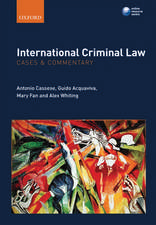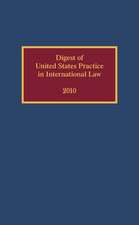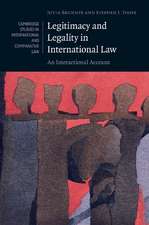An International Peace Court: Design for a Move from State Crime Toward World Law
Autor Thomas Holton Editat de George W. Keetonen Limba Engleză Paperback –
Preț: 378.71 lei
Nou
Puncte Express: 568
Preț estimativ în valută:
72.46€ • 75.66$ • 59.97£
72.46€ • 75.66$ • 59.97£
Carte tipărită la comandă
Livrare economică 04-18 aprilie
Preluare comenzi: 021 569.72.76
Specificații
ISBN-13: 9789401181815
ISBN-10: 9401181810
Pagini: 132
Ilustrații: XVI, 112 p. 1 illus.
Dimensiuni: 155 x 235 x 7 mm
Greutate: 0.2 kg
Ediția:1970
Editura: SPRINGER NETHERLANDS
Colecția Springer
Locul publicării:Dordrecht, Netherlands
ISBN-10: 9401181810
Pagini: 132
Ilustrații: XVI, 112 p. 1 illus.
Dimensiuni: 155 x 235 x 7 mm
Greutate: 0.2 kg
Ediția:1970
Editura: SPRINGER NETHERLANDS
Colecția Springer
Locul publicării:Dordrecht, Netherlands
Public țintă
ResearchCuprins
I. The Relevance of Law.- Responsibility for a Law of Peace.- The Placement of Responsibility.- The Format of Responsibility.- The Present Design.- II. International Violence: The Total Challenge and the Partial Response.- International Violence: The Total Challenge.- The Partial Response.- The Response Appraised.- III. Mission: A Move toward Law.- The Exercise of Responsibility.- Mission: A Move Toward World Law.- Credentials of Acceptability: Effectiveness and Legitimacy.- Summary.- IV. Medium: An International Peace Court.- The Choice of Means.- The Choice of Method.- The Choice of Medium.- V. The Court in Design.- Effective Structure.- Participants.- Summary.- VI. The Court in Action.- Jurisdiction.- Judges.- Parties.- Claims.- Trying the Facts.- Applying the Law.- The Judgment.- VII. The Court in Impact.- Operational Effect.- The Circuitry of Deterrence.- Legal Consequence.- VIII. New Premises for a Legal Breakthrough.- First Premise: The Initiative of the Many.- Second Premise: Moral Power as a Base of International Influence.- Third Premise: Moral Power Harnessed to Legal Structure.- Fourth Premise: Legal Judgment Free of the Consent of the Adjudged.- Fifth Premise: The Unique Method of Implementation of International Law.- Summary.- IX. Making the Move.- Establishment of the Court.- Maintenance of the Court.- Summary.- X. Toward World Law.- Blessed are the Peacemakers.- Making Peace.- Making Law.- Conclusion.- Epilogue.- Model Statute for an International Peace Court.- I. General Principles.- II. Organization of the Court.- III. Jurisdiction of Parties and Subject Matter.- IV. Procedure.- V. Amendment and Participation.- Author index.















